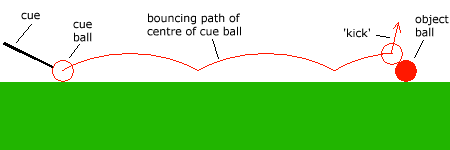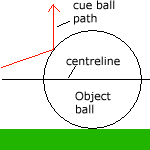
Snooker Balls Bounce
Yet another explanation of snooker kicks
A 'kick' in snooker happens when the cue ball strikes the object ball, and either the cue ball or the object ball bounces upwards, and the object ball doesn't go as far as expected, and in the wrong direction.
The kick was relatively unknown in snooker until recent years, when it has become more and more frequent - and vexing to players.
Several explanations have been put forward for kicks.
- Chalk or dust on the balls.
- Static electricity
- Humidity
- Temperature
The explanation proposed here is that kicks are caused when a snooker ball bounces across the snooker table, and strikes the object ball in such a manner as to cause either the cue ball or the object ball to bounce upwards.
Slow motion pictures of snooker balls in motion quite often show cue balls skipping on the table before they reach the object ball. This isn't very surprising, because snooker players very often strike down onto the cue ball, and this must result in the ball bouncing upwards during its subsequent forward motion. Any cue ball that has been struck downwards in this manner will become a bouncing cue ball. This bouncing cue ball will either strike the object ball as it is falling or when it is rising. If it strikes while it is rising, there is a likelihood that the impact of the rising cue ball on the object will throw it upwards. It is even more likely if the cue ball is already quite high off the table when it strikes the object ball.

If the cue ball is falling when it arrives at the object ball, its impact on the object ball will be likely to cause the object ball to be driven downwards onto the table, and for the object ball to bounce upwards.
 According to this theory, nasty cue ball kicks will only happen when the cue ball is high and rising when it strikes the object ball. And since a bouncing cue ball is going to be falling equally often as it is rising as it bounces down its path, it is at least 50% likely to strike while falling, and not produce a kick. And if the cue ball needs to be both high and rising when it strikes the object ball, it may well be that there are only relatively few points along its trajectory where a cue ball is doing this, and so the probability of getting a kick is a lot less than 50%.
According to this theory, nasty cue ball kicks will only happen when the cue ball is high and rising when it strikes the object ball. And since a bouncing cue ball is going to be falling equally often as it is rising as it bounces down its path, it is at least 50% likely to strike while falling, and not produce a kick. And if the cue ball needs to be both high and rising when it strikes the object ball, it may well be that there are only relatively few points along its trajectory where a cue ball is doing this, and so the probability of getting a kick is a lot less than 50%.
As a cue ball travels towards the object ball, successive bounces off the table will become less and less (same as with a tennis ball bouncing along a road), and so kicks must become less likely the further the object ball is from the cue ball.
The harder the cue ball is struck downwards, the higher off the table it is likely to bounce up, and the greater the likelihood of kicks. So the highest likelihood of kicks will occur when the cue ball is fairly near the object ball, and has been struck downwards by the cue - as when imparting backspin to the cue ball.
A further consequence of this theory is that when an object ball strikes high off the table against the object ball, it will strike at a different angle, throwing both cue and object balls in different directions than if they had collided at their midlines. Without doing the geometry to work this out precisely, it would seem that a high and rising cue ball will tend to push the object ball sideways more sharply than if it were hit perfectly at midline, and the cue ball will bounce off at a shallower angle.
Why does it happen more than it used to?
The explanation of why there are a lot more kicks in snooker than twenty or thirty years ago would be that snooker balls are now bouncing much more off the table than they ever used to do. And this may be because the finer cloths used on snooker tables not only allow balls to run more easily, but to bounce up higher. The difference may be proportionally as much as the difference in the greater bounce and run of a tennis ball on a clay court than on a grass court. Modern snooker tables are much more like clay courts, while the old snooker tables were like grass courts. In addition, modern snooker balls may be more elastic, and so bouncier.
Temperature and humidity may play a part in kicks, to the extent that they change they characteristics of the table cloth, increasing or decreasing its cushioning or bounce-reducing properties. If the cloth on a snooker table absorbs moisture, it may well become less bouncy, and less prone to produce kicks, much as a wet lawn is less bouncy than a dry lawn. This suggests that dry and warm air will result in more kicks as balls bounce higher.
Chalk and dust on the balls may have a small additional effect. But so also may chalk and dust on the table. A rolling ball moving over an obstruction is going to be given a small kick upwards which may add to (or subtract from) any other vertical motion in a bouncing cue ball.
What can be done about it?
According to this theory, it is the elasticity of snooker balls, and the reduced cushioning effect of the baize table cloth, that causes periodic and unpredictable kicks. If snooker players played with rubber balls on a flat slate table, they would be getting kicks all the time. Kicks could be reduced by covering tables with a thicker cloth to reduce cue ball bounce. Kicks might also be reduced by using slightly heavier balls, or slightly smaller cue balls than object balls, so that it is harder for the midline of a cue ball to rise above that of an object ball.
